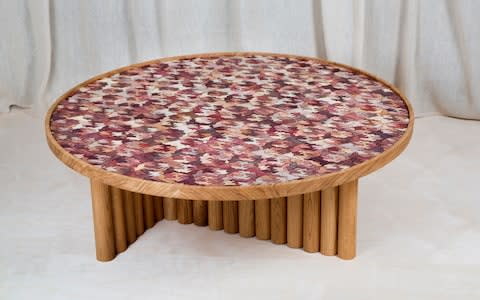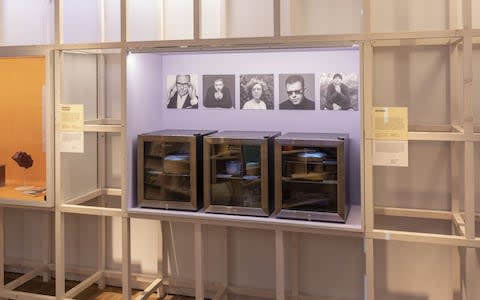Human cheese and edible water bottles: new V&A exhibition tackles food waste

Human cheese: not the most appetising of thoughts. If you were offered one of these funky stiltons at a dinner party, you'd be forgiven for responding with a whiff of scepticism. Yet a Heston Blumenthal comte, an Alex Jones Cheshire cheese, a Suggs cheddar, a Professor Green mozzarella and a Ruby Tandoh stilton are on display at the V&A's new exhibition, FOOD: Bigger than the Plate, which opens on Saturday.
The exhibition takes a wide-ranging, in-depth look at our relationship to food. At a time when our knowledge of the food cycle has perhaps reached a record low, FOOD examines what artists, scientists, farmers, chefs and communities are doing to combat some of the major issues of the day, such as food waste and diminishing biodiversity.
Its debut couldn't be timelier. Plastic is conquering our planet at an alarming rate, and was this week found 6.8 miles below the sea. A third of food produced globally is binned. Increasingly, loss of biodiversity is considered as catastrophic as climate change, and a million species are set to become extinct over the coming century. As the exhibition's opening gambit proclaims – "If you are a consumer, you are also a producer. The basic act of eating creates 'waste'".
"In today's politically, ecologically and socially turbulent times the question of how we feed ourselves has never been more pressing," says V&A director Tristram Hunt, who attended a symposium on food waste at the museum earlier this week with Michael Gove. "The future of food is something that impacts on every one of the world's citizens. Our current food system, much of which took shape during the agricultural and industrial revolutions, needs redesigning for our modern societies."

Thankfully, then, plenty of clever, imaginative folk across the globe are doing just that, and curators May Rosenthal Sloan and Catherine Flood have collated 70 exhibits that are by turn funny, scary, intriguing, disgusting, entertaining, thought-provoking and educational.
Did you know, for example, that most chickens we eat today descend from a 1948 competition to breed the perfect bird? Or that the overwhelming majority of the biomass of a coffee bean is wasted?
The exhibition is divided into four sections: 'Compost', 'Farming', 'Trading' and 'Eating'. It starts with arguably the most compelling: Compost. Here, we are warned about the current "flush and forget" culture, which has replaced the natural "nutrient loop" between humans and their surroundings, whereby all waste, from food to excrement, was once useful in some form. "Waste does not have to be the end of the line. It can be the beginning of the food story," a label – made of a corn byproduct – states.
Some highlights: Disgusting Substances, a project glazing ceramic vases with human urine and creating egg cups from cow's blood. Urban Mushroom are using coffee grounds from the V&A's cafe to grow oyster mushrooms on what look like giant hanging salamis. No prizes for guessing what Merdacotta create, but for those who aren't versed in the Latin languages, it's terracotta-like pots made from cow dung. And a heartening tale comes from Mexico, where Totomoxtle has mixed art and furniture making with farming to turn corn husks from ancient varieties into beautiful patchwork art – providing income for families and ensuring more species of corn are grown, helping biodiversity.

While the exhibition engages with the stark realities of the food industry, where it succeeds is in not bashing you round the head with bleakness – it's a tale as much of hope as fear. "We absolutely wanted to foster an environment of criticism, but hope and optimism as well," Rosenthal Sloan told The Telegraph.
It's in 'Farming' where the harsh realities of the industry are most evident, particularly in a screening of the 2005 documentary Our Daily Bread, which highlights industrial meat production. Separately, This Little Piggy sees artist Elaine Tin Nyo follow a Basque pig from birth to ham (with suitably affecting imagery).
But there are positives, too, particularly Planetary Community Chicken. Since 1999, Belgian artist Koen Vanmechelen has cross-bred chickens from different countries in a bid to create a more resilient, longer-living and less disease-prone bird. "What started as a kind of poetic comment on diversity has turned into a beautiful example of science following art," says Rosenthal Sloan.
Trading and Eating are a little whistle-stop, but intriguing nonetheless. Posters from the V&A's archive illustrate how our relationship to food has been comprehensively altered by marketing since the late 19th century – from sensory and experiential to visual. Packaging has helped foster a bucolic image of farming – The Laughing Cow, for example – when the truth is anything but. The infamous Sun Raid Raisins poster feels particularly well chosen here.
We end with what everything boils down to: Eating. Two projects stand out. Ooho!'s edible water bottle is another example of science and art merging. Created by a team at the Royal College of Art, these biodegradable and edible water pouches are soon to be used for Just Eat's sauce sachets.

And finally, the cheese. Thankfully, you may think, there aren't any samples – it might not even be edible. Bacteria are taken from the celebrities (Heston's pubic hair, for example), and used as the starter culture. Apparently, the similarities between cheese aromas and body odours are not a coincidence, and the microbes involved in cheesemaking share many of the characteristics of those found on human skin. The cheeses are not yet approved for consumption, but the producers hope they'll help challenge negative perceptions many of us hold about the microbial world.
This journey through the food cycle is entertaining and educational. One glaringly obvious point is the lack of government-led schemes on show. Does the public sector need to get more imaginative? "Yes, I suppose that's one of our hopes," says Rosenthal Sloan.
Museums, by their nature, are retrospective. On this important topic, FOOD, three years in the making, though acknowledging the past for context, looks to the future for solutions – and it couldn't arrive at a better time.
FOOD: Bigger than the Plate will run at the V&A between 18 May and 20 October 2019

